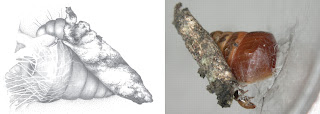I can't answer that. So ...
Ooh look ...
What's that over there? A snail-eating caterpillar?
Adults of the Hawaiian moth Hyposmocoma molluscivora (Cosmopterigidae) are small, grey and largely nondescript—except for luxuriant feathery fringes along the trailing edges of the hind wings. Their larvae appear about as unremarkable. They are small, brown and largely nondescript. But whereas the caterpillars of other Hyposmocoma feed on the usual fare of plant material, those of H. molluscivora prey on snails.
When a snail is attacked, it retreats into the shelter of its shell. A predator's only options are to break the shell or follow the snail. If the snails seals the opening of its shell by sticking it down to a leaf or stone, that's pretty much it for the smaller predator. Time to move on and find a less alert potential meal.
The caterpillar of H. molluscivora maximises its chances of getting dinner by trussing up the snail with silk. Most caterpillars produce silk, which they use for a variety of purposes including building retreats, but only the Maui snail-killer also employs it to tether prey.

On encountering one of the small native Tornatellides snails, the caterpillar crawls onto the shell and swathes it in silk. Then it follows the snail as it retreats as far as it can. When there's nowhere left for the snail to go, the caterpillar dines at leisure.
Some caterpillars add the empty shells as ornaments to their transportable cases. But I don't think it's in some weird serial snail-killer sort of way.
[Image from Rubinoff & Haines]
References
Rubinoff, D. & Haines, WP. (2005). Web-spinning caterpillar stalks snails. Science 309: 575.
Rubinoff, D. & Haines, WP. (2005). Hyposmocoma molluscivora description. Science 311: 1377.